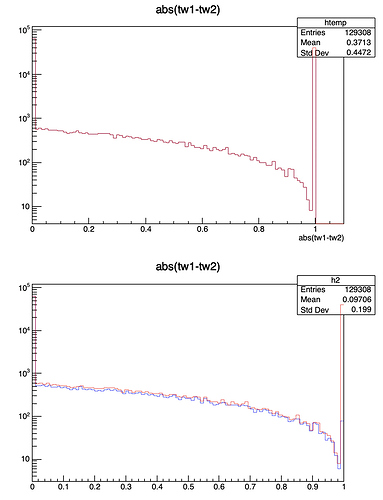I have modified a bit your macro to make it more clear.
{
TFile f("Fig_9_0.root");
auto C = new TCanvas("C","C",600,800);
C->Divide(1,2);
C->cd(1);
nt->Draw("abs(tw1-tw2)");
nt->Draw("abs(tw1-tw2)>>h(100, 0, 1)", "", "same");
printf("Number of bins in h = %d\n", h->GetNbinsX());
printf("h xmin = %g\n", h->GetXaxis()->GetXmin());
printf("h xmax = %g\n", h->GetXaxis()->GetXmax());
h->SetLineColor(2);
gPad->SetLogy(1);
C->cd(2);
nt->Draw("abs(tw1-tw2)>>h2(100, 0, 1)");
printf("\nNumber of bins in h2 = %d\n", h2->GetNbinsX());
printf("h2 xmin = %g\n", h2->GetXaxis()->GetXmin());
printf("h2 xmax = %g\n", h2->GetXaxis()->GetXmax());
h->SetLineColor(2);
h->Draw("same");
h2->SetLineColor(4);
gPad->SetLogy(1);
}
it gives the output:
Number of bins in h = 100
h xmin = 0
h xmax = 1.1
Number of bins in h2 = 100
h2 xmin = 0
h2 xmax = 1
and the picture:
So it is clear that h and h2 have different upper limits and that option “same” for h forces the upper limit to be equal to the upper limit of the plot already on the canvas. I would suggest you do but the following way:
{
TFile f("Fig_9_0.root");
auto C = new TCanvas("C","C",600,800);
C->Divide(1,2);
C->cd(1);
auto h = new TH1D("h","h",100, 0, 1);
nt->Draw("abs(tw1-tw2)");
nt->Draw("abs(tw1-tw2)>>h", "", "same");
printf("Number of bins in h = %d\n", h->GetNbinsX());
printf("h xmin = %g\n", h->GetXaxis()->GetXmin());
printf("h xmax = %g\n", h->GetXaxis()->GetXmax());
h->SetLineColor(2);
gPad->SetLogy(1);
C->cd(2);
auto h2 = new TH1D("h2","h2",100, 0, 1);
nt->Draw("abs(tw1-tw2)>>h2");
printf("\nNumber of bins in h2 = %d\n", h2->GetNbinsX());
printf("h2 xmin = %g\n", h2->GetXaxis()->GetXmin());
printf("h2 xmax = %g\n", h2->GetXaxis()->GetXmax());
h->SetLineColor(2);
h->Draw("same");
h2->SetLineColor(4);
gPad->SetLogy(1);
}
The output is:
Number of bins in h = 100
h xmin = 0
h xmax = 1
Number of bins in h2 = 100
h2 xmin = 0
h2 xmax = 1
